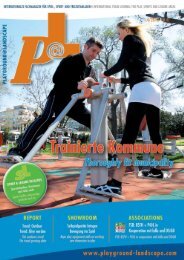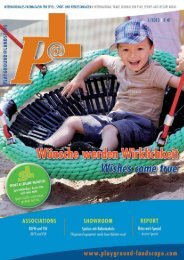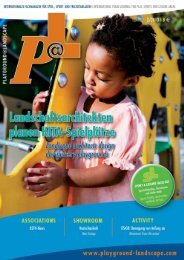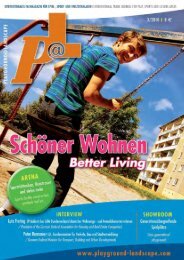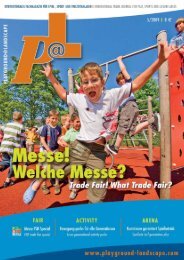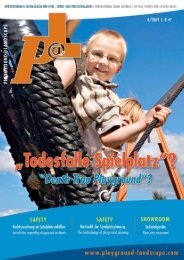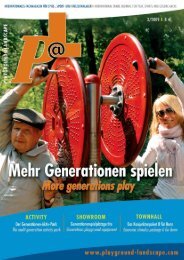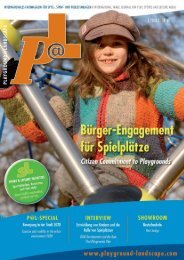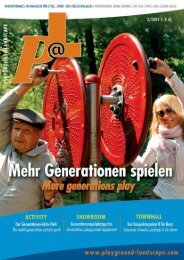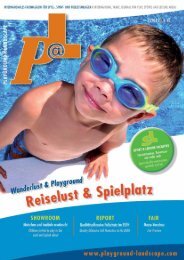School playgrounds - Playground@Landscape
School playgrounds - Playground@Landscape
School playgrounds - Playground@Landscape
Sie wollen auch ein ePaper? Erhöhen Sie die Reichweite Ihrer Titel.
YUMPU macht aus Druck-PDFs automatisch weboptimierte ePaper, die Google liebt.
<strong>School</strong> recreation area as playground: views<br />
Detlef Thiel, Head of the Office for Urban Greenspace<br />
and Waste Management, Dresden<br />
“The availability of <strong>playgrounds</strong>, particularly those suitable for children<br />
aged up about to 12 years, has improved significantly in recent years.<br />
At the same time, there is a dearth of sport-orientated facilities for<br />
youngsters, especially ball sports fields. The playground development<br />
concept that is currently being drawn up will show that there is a 50%<br />
shortfall when it comes to space. As the necessary areas are no longer<br />
available, or can only be created with considerable effort, school <strong>playgrounds</strong><br />
become interesting because of their potential for diverse usage.<br />
The notion of opening up school <strong>playgrounds</strong> is frequently put on the<br />
political agenda in Dresden, but the school authorities, except in a few<br />
exceptional cases, are unable to make this viable because of a range of<br />
legal and commercial problems. <strong>School</strong> <strong>playgrounds</strong> generally lack play<br />
equipment. There a few sports fields that are open after school hours.<br />
These are already being used by schools and sometimes also by clubs<br />
into the late afternoon, but residential noise avoidance regulations<br />
mean that these cannot be opened at other times to the general public.<br />
In addition, many primary schools also incorporate nursery schools<br />
that also have outdoor recreation areas that are used into the late afternoon,<br />
but no nursery school playground has yet been opened up to<br />
public use. Despite all this, we need to keep the multiuse principle in<br />
mind for future planning.”<br />
Volker Schwarz, Head of the Department of Parks,<br />
Landscapes and Forestry, Heidelberg:<br />
“Heidelberg, represented by its Landscape and Forestry Department, is<br />
currently maintaining 131 <strong>playgrounds</strong> and school recreation fields<br />
scattered throughout the city. Under the municipal playground regulations,<br />
these are now accessible for the general public and can be freely<br />
used. Various voluntary groups, the church and housing development<br />
organisations also offer play facilities. The 1976 regulations governing<br />
the use of public <strong>playgrounds</strong> in Heidelberg (most recently revised in<br />
2005) specify that school <strong>playgrounds</strong> are to be accessible as public<br />
<strong>playgrounds</strong> out of school hours.<br />
We consider this opening up of schoolyards as public <strong>playgrounds</strong><br />
necessary to meet the actual need for such amenities in the various<br />
districts of our city. In some instances, we have encountered resistance<br />
from local residents, particularly in the more densely populated<br />
22<br />
Schulträgern bis auf wenige Ausnahmen wegen vorgetragener<br />
rechtlicher, aber auch wirtschaftlicher Gründe nicht<br />
umsetzbar. Die Schulhöfe sind grundsätzlich nicht mit Spielgeräten<br />
ausgestattet, Sportplätze gibt es einige wenige, die<br />
nach Schulschluss geöffnet sind. Oft werden sie aber von der<br />
Schule, manchmal auch von Vereinen bis in den späten Nachmittag<br />
genutzt, andererseits erlauben die Lärmemissionen<br />
keine zusätzliche öffentliche Nutzung. Darüber hinaus beherbergen<br />
viele Grundschulen auch Horte, die über Spielplatzflächen<br />
verfügen, diese werden aber ebenfalls bis in den<br />
späten Nachmittag genutzt, bisher existiert kein geöffneter<br />
Hortspielplatz. Am Ziel der Mehrfachnutzung sollte trotz allem<br />
weiter fest gehalten werden.“<br />
Volker Schwarz, Stadt Heidelberg, Abteilungsleiter<br />
Grünanlagen, Landschafts- und Forstamt:<br />
„Die Stadt Heidelberg, vertreten durch das Landschafts- und<br />
Forstamt, unterhält derzeit 131 über das gesamte Stadtgebiet<br />
verteilte Spielplätze und Schulhöfe. Diese sind im Rahmen der<br />
städtischen Spielplatzsatzung öffentlich zugänglich und frei<br />
nutzbar. Weitere Spielangebote bestehen bei freien Trägern,<br />
Kirchen sowie den Wohnungsbaugesellschaften. Laut Satzung<br />
über die Benutzung der Öffentlichen Kinderspielplätze der<br />
Stadt Heidelberg von 1976 (zuletzt geändert 2005) sind auch<br />
die Schulhöfe in der unterrichtsfreien Zeit als öffentliche<br />
Spielplätze zugänglich.<br />
Die Öffnung der Schulhöfe als öffentliche Spielplätze erachten<br />
wir als angemessen, um auf den konkreten Bedarf in einzelnen<br />
Stadtteilen reagieren zu können. Teilweise bestehen<br />
Konflikte mit Anwohnern, vor allem in stark verdichteten<br />
Bereichen wie der Heidelberger Altstadt. Durch Abstimmungen<br />
unter Beteiligung aller Betroffenen und entsprechenden<br />
Sonderregelungen kann dem in aller Regel abgeholfen werden.<br />
Grundsätzlich kann das Spielplatzangebot in Heidelberg als<br />
ausreichend bezeichnet werden. Die Verteilung der Spielplätze<br />
auf die 14 Stadtteile Heidelbergs, deren Flächenanteil sowie<br />
deren qualitative Ausstattung sind verhältnismäßig ausgeglichen.<br />
Um auf den sich ändernden Bedarf sowie die demographische<br />
Entwicklung zu reagieren, hat die Stadt Heidelberg



